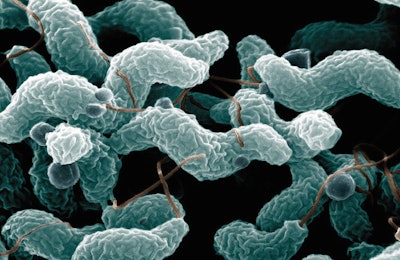
Antibiotic resistance genes that are prevalent in the foodborne pathogen, Campylobacter jejuni, can linger after the initial infection and cause additional sickness and further resistance to life-saving drugs, revealed new research published in the journal, Microbial Genomics.
“Antibiotic resistance genes like those conferring resistance to the beta-lactam class of antibiotics, are carried on plasmids (extra pieces of DNA) that can be easily transferred between bacteria commonly found in poultry and their environment. This transfer is difficult to control, and because of natural selection, the likelihood of transfer increases when antibiotics are used,” explained Shannon Manning, the project’s leader and a research foundation professor in the Department of Microbiology and Molecular Genetics at Michigan State University.
Campylobacter is responsible for 1.5 million illnesses in the U.S. each year, the Center for Disease Control and Prevention (CDC) estimates. Approximately four out of every five instances of Campylobacter in people results from handling and eating contaminated chicken meat.
The bacteria can be difficult to treat, and many strains are now multi-drug resistant, concluded a recent report, making Campylobacter control even more challenging.
The antibiotic resistance gene swap
More than half of the 214 C. jejuni samples isolated from patients in Michigan contained antibiotic resistance genes against at least one antibiotic, according to the research.
In addition, the study showed that the antibiotic resistance genes can linger long after someone fights off an infection. Other microbes can then pick up these genes to gain resistance of antibiotics.
Whole genome sequencing also revealed that the source of most of the C. jejuni infections came from consuming either contaminated beef or poultry.
“It will be important for poultry farms to continue using antibiotics judiciously and to limit or restrict use of antibiotics that are medically important for human and animal health,” Manning said.
“Although we do not have any Campylobacter recovered from poultry available to examine, we are in the process of comparing these genomes to those from wild birds and cattle in Michigan. The goal of these analyses is to identify those genomic traits or genotypes that are specific to the strains causing human infections.”













